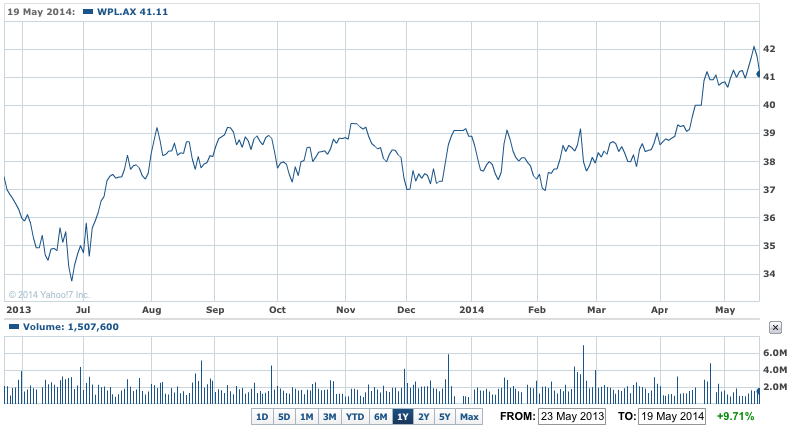Like so many companies these days, Woodside Petroleum (WPL) managed this week’s news flow very adroitly, separating the news of the abandonment of a $2.5 billion expansion into a huge gas development offshore Israel, and then a day later raising the prospect of a big new gas development on the northwestern coast of Western Australia.
It was a reversal of the bad news/good news split so many companies these days are using – the ending of the Israel interest was ‘good news’ because it raised shareholder hopes of more returns, yesterday’s briefing for investors raised the prospect of not so much money, and some spending on projects and debt repayment.
At the same time, the company yesterday promised a "disciplined" investment approach in deciding on its next growth phrase, thereby managing to maintain the idea (in the minds of some investors at least) that a cash return or higher dividends would be considered.
The company told the briefing in Sydney yesterday its priorities would be servicing its debt, dividends to shareholders, capital investment for growth, and then returning surplus cash to shareholders.
It was a difficult juggling game for a company which abandoned most of its ambitious expansion plans two years ago to placate investors who wanted a more disciplined approach to spending, costs and capital management.
The company has duly delivered, lifting dividends and maintaining a tough minded approach to new projects and to operating costs under CEO Peter Coleman.
At the investor briefing in Sydney, Mr Coleman also said the company wasn’t really worried by the big gas deal done between Russia and China.
He rejected suggestions that the deal would make it more difficult to market LNG from Woodside’s $40 billion-plus Browse floating LNG venture, indicating that project was targeting Japan rather than China.
"The Chinese have been very good over time at managing security of supply so I don’t believe they are going to over-commit to any one particular source of gas over time," Mr Coleman was quoted in media reports of the briefing.
"The Chinese market always is one where you had gas-to-gas competition through pipelines. This is just another supply source."
Woodside said in the documentation for the briefing that when it was considering new investment decisions, the ideal investment size would be between $US1 billion and $US5 billion in an asset that had "strategic fit and rationale”. It expected to have an equity share of between 25% and 40% in complex, capital intensive projects.
"Every investment must stand on its own merits," it said in the documentation.
The huge Browse project looms as the big test of this disciplined approach.
Woodside has previously told the market it wants to start initial engineering and design in the Browse Floating LNG project later this year, and is aiming to make a final investment decision in the second half of this year.
"Clearly we’re focused on disciplined capital allocation and capital efficiency," Mr Coleman said in comments at the start of his briefing.
He also said Woodside needs to be "a better explorer", and said the future for the company "remains very positive”.
Woodside’s chief financial officer Lawrie Tremaine told the briefing Woodside had $US6 billion of cash and additional debt potential to support its strategy.
Mr Tremaine pointed to debt servicing as the top priority for Woodside. It would then have to prioritise either dividends or capital spending to sustain growth.
Woodside would always seek to do both and any surplus cash that remained after meeting these objectives, would be returned to shareholders "when appropriate".
He also said the company was looking at Minimal equity issuance: in its next growth phase, which should also please investors.
Mr Tremaine outlined a "measured" increase in spending on exploration to about $US650 million a year, while between $US100 million and $US150 million would go on investment to sustain the base business each year, about $US300 million a year on extending the life of producing assets and the rest on the Browse project.
He said Woodside’s higher payout ratio of 80%, which was set last year, would be continued "for the foreseeable future", an announcement which pleased many investors.
WPL 1Y – Woodside assures investors

On the Browse project, which is being reworked from the original plan of an onshore LNG plant at James Price Point to a floating plant, Woodside again said it saw the best solution to develop the field was a floating LNG operation.
The base case for the project involves three identical floating LNG facilities, each producing about 3.9 million tonnes a year of LNG and up to 22,000 barrels of condensates each day.
Assuming a final investment decision in the second half of 2015, commissioning of the project would start 5 to 6 years later – so in 2020-21 – and production would continue for 40-50 years.
In other words it will be enormous. If the Prelude project of Shell in the same region is estimated to cost around $12 billion, Browse could cost three or four times that.
PetroChina is a major Browse partner, along with the Japanese MIMI venture between Mitsubishi and Mitsui. Indications yesterday were the project would be aimed at Japan, rather than China.
Woodside shares rose 1.2% to $41.72. They are up 2% over the past two days of major announcements, which is probably the sort of reaction management was looking for.













